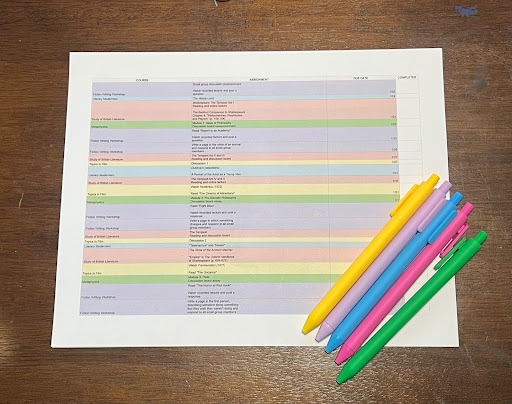
The transition from the comfort of a month-long break to the rigors of academic life can be both exhilarating and overwhelming as college students begin a new semester of courses. To navigate this challenging period in a more effective way, a well-organized to-do list can make all the difference. Whether you’re a freshman or a graduate student, this guide will offer valuable tips to streamline a routine and set the stage for a successful semester.
Embrace the Essentials
The best place to start is with the basics. Prioritizing essential tasks for the semester will pave the way for a smoother transition. Oftentimes, these tasks are not difficult, but come all at once and can seem incredibly overwhelming.
One of the most seemingly anxiety-inducing first tasks that students must undergo is purchasing necessary textbooks. The St. John’s bookstore has each student’s course list, making the required books easy to find; they can be rented and bought in both digital and hardcopy forms. However, if students are looking for a cheaper option, Amazon sometimes offers a more affordable price, or PDF versions can be found online for free through sites such as Library Genesis+ and Project Gutenberg.
Another essential that is absolutely necessary for a new term is finalizing your class schedule. While it may seem like your classes for the upcoming semester are established in the prior one, this is not always the case. It is not uncommon for students to attend a first class meeting and decide that the course does not have the curriculum that was advertised or they feel that the class will add unnecessary pressure to an already stressful semester. Whatever the reasoning may be, students should prioritize their academic abilities over the pressure of grades.
Establish a Color-Coded System
A highly effective way to maintain organization throughout the semester is by creating a color-coded spreadsheet. This tool becomes a roadmap, helping students keep track of assignments, due dates and class schedules in a visual manner.
Whether using Microsoft Excel or Google Sheets, students can start by creating a spreadsheet with columns for each day of the week and rows corresponding to classes. Be sure to include specific details like class names, professors and room numbers so as to become acquainted with this information.
Next, assign a unique color to each course to create a visual distinction. This color-coding system will allow for quick identification and help prevent confusion when looking at the schedule. Within these colored cells, list all assignments, exams and project due dates under the respective course column. This step provides a comprehensive overview of your academic obligations for the semester.
The last step is to update the spreadsheet regularly. By consistently updating the completion, extension or even new deadlines that arise, students can ensure that they stay on top of their workload and minimize the risk of last-minute surprises.
Stay Flexible
While a to-do list provides structure, it is incredibly important to remain flexible. Inevitably, there will be unexpected challenges that arise, and it is crucial to not let them hinder your ability to tackle an obstacle.
Being open to adjusting your schedule when necessary is just as important as maintaining a proactive approach to academic responsibilities. One key benefit of flexibility is the ability to optimize learning experiences. As courses progress during the semester, students may encounter new topics or teaching styles that require adjustments in study strategies.
Remaining adaptable fosters a proactive mindset; however, life’s unpredictability extends beyond academics. Personal and professional commitments may fluctuate, necessitating a flexible schedule to accommodate other responsibilities. Students who prioritize flexibility may find it easier to strike a harmonious balance between academic pursuits and other aspects of life.







